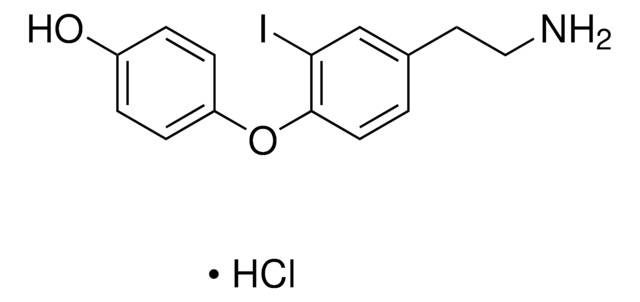T-075
3,3′,5′-Triiodo-L-thyronine (Reverse T3) solution
100 μg/mL in methanol with 0.1N NH3, ampule of 1 mL, certified reference material, Cerilliant®
Sinónimos:
3,3′,5′-Triiodo-L-thyronine, Reverse T3, rT(3)
About This Item
Productos recomendados
grado
certified reference material
Formulario
liquid
Características
Snap-N-Spike®/Snap-N-Shoot®
envase
ampule of 1 mL
fabricante / nombre comercial
Cerilliant®
concentración
100 μg/mL in methanol with 0.1N NH3
técnicas
gas chromatography (GC): suitable
liquid chromatography (LC): suitable
aplicaciones
clinical testing
clinical testing
Formato
single component solution
temp. de almacenamiento
−20°C
cadena SMILES
N[C@@H](Cc1ccc(Oc2cc(I)c(O)c(I)c2)c(I)c1)C(O)=O
InChI
1S/C15H12I3NO4/c16-9-3-7(4-12(19)15(21)22)1-2-13(9)23-8-5-10(17)14(20)11(18)6-8/h1-3,5-6,12,20H,4,19H2,(H,21,22)/t12-/m0/s1
Clave InChI
HZCBWYNLGPIQRK-LBPRGKRZSA-N
¿Está buscando productos similares? Visita Guía de comparación de productos
Descripción general
Información legal
Producto relacionado
Palabra de señalización
Danger
Frases de peligro
Consejos de prudencia
Clasificaciones de peligro
Acute Tox. 3 Dermal - Acute Tox. 3 Inhalation - Acute Tox. 3 Oral - Aquatic Chronic 3 - Flam. Liq. 2 - STOT SE 1
Órganos de actuación
Eyes,Central nervous system
Código de clase de almacenamiento
3 - Flammable liquids
Clase de riesgo para el agua (WGK)
WGK 2
Punto de inflamabilidad (°F)
49.5 °F - closed cup
Punto de inflamabilidad (°C)
9.7 °C - closed cup
Elija entre una de las versiones más recientes:
Certificados de análisis (COA)
It looks like we've run into a problem, but you can still download Certificates of Analysis from our Documentos section.
Si necesita más asistencia, póngase en contacto con Atención al cliente
¿Ya tiene este producto?
Encuentre la documentación para los productos que ha comprado recientemente en la Biblioteca de documentos.
Los clientes también vieron
Protocolos
Determination of the thyroid hormones T4, T3 and rT3 from plasma using an Ascentis Express RP-Amide cartridge to trap the analytes, and a Phenyl-Hexyl column to resolve them.
Nuestro equipo de científicos tiene experiencia en todas las áreas de investigación: Ciencias de la vida, Ciencia de los materiales, Síntesis química, Cromatografía, Analítica y muchas otras.
Póngase en contacto con el Servicio técnico













